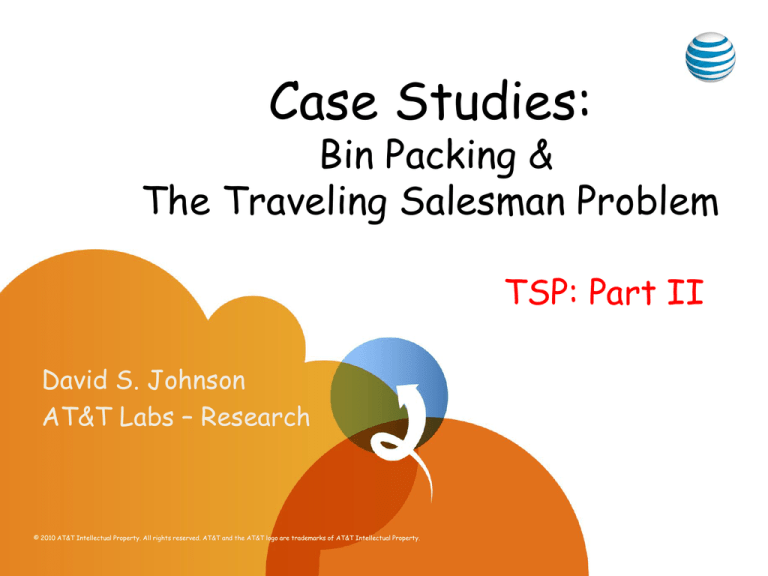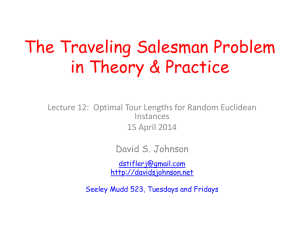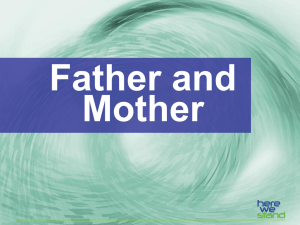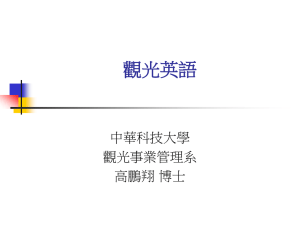
Case Studies:
Bin Packing &
The Traveling Salesman Problem
TSP: Part II
David S. Johnson
AT&T Labs – Research
© 2010 AT&T Intellectual Property. All rights reserved. AT&T and the AT&T logo are trademarks of AT&T Intellectual Property.
To the Students of the
2010 Microsoft School on Data Structures and Algorithms
•
Thanks for all your “Get Well” wishes. I am back in the USA now and
almost fully recovered. I am truly sorry I was unable to present my
Friday lectures and my Q&A session. I had been looking forward to
both.
•
Given that I missed the Q&A session, feel free to send me email if you
have any questions I might help you with (technical or otherwise). My
email address is dsj@research.att.com.
•
I hope these slides (and the Bin Packing slides I am also uploading) are
still of some value, even without the vocal commentary I would have
provided had I been able to give the talks. I still owe you a
bibliography, but you can find many of my own TSP and bin packing
papers at http://www.research.att.com/~dsj/, along with NPcompleteness columns and other goodies.
•
Best wishes to you all -- David Johnson, 18 August, 2010.
Special Request
2-Opt Animation: Nearest Neighbor Starting Tour
Special Bonus:
Bob Tarjan
Picture from Shaggier Times (~1976)
Mike Garey
David Johnson
And Now,
Back to the show.
For more on the TSP algorithm performance, see the website for the
DIMACS TSP Challenge:
http://www2.research.att.com/~dsj/chtsp/index.html/
Comparison: Smart-Shortcut Christofides versus 2-Opt
Tour Length
Normalized Running Time
Held-Karp (or “Subtour”) Bound
• Linear programming relaxation of the following
formulation of the TSP as an integer program:
• Minimize
city pairs {c,c’}(x{c,c’}d(c,c’))
• Subject to
–
c’C x{c,c’} = 2, for all c C.
–
cS,c’C-S x{c,c’} ≥ 2, for all S C (subtour constraints)
– x
{0,1}
0{c,c’}
≤ x{c,c’}
≤ 1 , for all pairs {c,c’} C.
Linear programming relaxation
Percent by which Optimal Tour exceeds Held-Karp Bound
Computing the Held-Karp Bound
• Difficulty: Too many “subtour” constraints:
cS,c’C-S x{c,c’} ≥ 2, for all S C
(There are 2N-2 such S)
• Fortunately, if any such constraint is violated by our current
solution, we can find such a violated constraint in polynomial time:
• Suppose the constraint for S is violated by solution x. Consider
the graph G, where edge {c,c’} has capacity x{c,c’} . For any pair of
vertices (u,v), u S and v C-S, the maximum flow from u to v is
less than 2 (and conversely).
• Consequently, an S yielding a violated inequality can be found
using O(N) network flow computations, assuming such an
inequality exists.
Computing the Held-Karp Bound
• Pick a city c. If the desired cut exists, there must be some
other city c’ such that the max flow from c to c’ is less than 2 (a
“small flow”).
• Test all candidates for c’ (N-1 flow computations)
• If no small flows found, no subtour constraint is violated.
• Otherwise, let c* be a c’ with a small flow.
• Initialize S to {c}.
• For each other city c’ in turn, merge c’ with all the cities in S
and test whether the flow from the merged vertex to c*
remains small.
– If yes, add c’ to S.
– Otherwise, add c’ to C-S.
• Once all N-2 candidates for c’ have been tested, output S.
(Total time can be reduced to that for a constant number of flow computations
using more algorithmic ideas.)
Optimization: State of the Art
Lin-Kernighan [Johnson-McGeoch Implementation]
1.4% off optimal
10,000,000 cities in 46 minutes at 2.6 Ghz
Iterated Lin-Kernighan [J-M Implementation]
0.4% off optimal
100,000 cities in 35 minutes at 2.6 Ghz
Concorde Branch-and-Cut Optimization
[Applegate-Bixby-Chvatal-Cook]
Optimum
1,000 cities in median time 5 minutes at 2.66 Ghz
Concorde
•
“Branch-and-Cut” approach exploiting linear programming to determine
lower bounds on optimal tour length.
•
Based on 30+ years of theoretical developments in the “Mathematical
Programming” community.
•
Exploits “chained” (iterated) Lin-Kernighan for its initial upperbounds.
•
Eventually finds an optimal tour and proves its optimality (unless it
runs out of time/space).
•
Also can compute the Held-Karp lower bound for very large instances.
•
Executables and source code can be downloaded from
http://www.tsp.gatech.edu/
Geometric Interpretation
Hyperplane
perpendicular
to the vector
of edge lengths
Optimal Tour
-- Points in RN(N-1)/2 corresponding to a tour.
Optimal Tour is a point on the convex hull of
all tours.
Facet
Unfortunately, the LP relaxation of the TSP can be a very
To improve
it, add to
more
poor
approximation
theconstraints
convex hull (“cuts”)
of tours.
One Facet Class: Comb Inequalities
H
T1
T2 T3
Ts-1
Ts
Teeth Ti are disjoint, s is odd,
all regions contain at least one city.
H
T1
T2
T3
Ts-1
Ts
• For Y the handle or a tooth, let x(Y) be the total
value of the edge variables for edges with one
endpoint in Y and one outside, when the function x
corresponds to a tour
• By subtour inequalities, we must have x(Y) ≥ 2 for
each such Y. It also must be even, which is exploited
to prove the comb inequality:
s
x(H) x(Ti ) 3s 1
i1
Branch & Cut
• Use a heuristic to generate a initial “champion” tour
and provide provide an upper bound U ≥ OPT.
• Let our initial “subproblem” consist of an LP with just
the inequalities of the LP formulation (or some subset
of them).
• Handle subproblems as follows:
Branch & Cut
• Keep adding violated inequalities (of various sorts) that you can
find, until
– (a) LP Solution value ≥ U. In this case we prune this case and
if no other cases are left, our current tour is optimal.
– (b) Little progress is made in the objective function. In this
case, for some edge {c,c’} with a fractional value, split into
two subproblems, one with x{c,c’} fixed at 1 (must be in the
tour, and one with it fixed at 0 (must not be in the tour).
• If we ever encounter an LP solution that is a tour and has length
L’ < L, set L = L’ and let this new tour be the champion. Prune any
subproblems whose LP solution exceeds or equals L. If at any
point all your children are pruned, prune yourself.
U = 97
Initial LP, U = 100, LB = 90
X{a,b} = 0
X{a,b} = 1
LB = 92
X{c,d} = 0
LB = 92
LB = 93
X{c,d} = 1
LB = 100
X{a,c} = 0
LB = 98
X{a,c} = 1
LB = 97
New Opt = 97
X{e,a} = 0
LB = 101
X{e,a} = 1
LB = 100
Current World Record (2006)
Using a parallelized version of the
Concorde code, Helsgaun’s
sophisticated variant on Iterated
Lin-Kernighan, and 2719.5 cpu-days
N = 85,900
The optimal tour is 0.09% shorter than the tour DSJ constructed using Iterated Lin-Kernighan
in 1991. In 1986, when computers were much slower, we could only give the Laser Logic people a
Nearest-Neighbor tour, which was 23% worse, but they were quite happy with it…
Running times (in seconds)
for 10,000 Concorde runs
on random 1000-city planar
Euclidean instances (2.66
Ghz Intel Xeon processor
in dual-processor PC,
purchased late 2002).
Range: 7.1 seconds
to 38.3 hours
Concorde Asymptotics
[Hoos and Stϋtzle, 2009 draft]
• Estimated median running time for
planar Euclidean instances.
• Based on
– 1000 samples each for N = 500,600,…,2000
– 100 samples each for N = 2500, 3000,3500,4000,4500
– 2.4 Ghz AMD Opteron 2216 processors with 1MB L2 cache
and 4 GB main memory, running Cluster Rocks Linux v4.2.1.
0.21 · 1.24194 N
Actual median for N = 2000: ~57 minutes, for N = 4,500: ~96 hours
Theoretical Properties of Random
Euclidean Instances
Expected optimal tour length for an N-city
instance approaches CN for some constant
C as N . [Beardwood, Halton, and Hammersley, 1959]
Key Open Question:
What is the Value of C?
The Early History
• 1959: BHH estimated C .75, based on hand solutions for a
202-city and a 400-city instance.
• 1977: Stein estimates C .765, based on extensive simulations
on 100-city instances.
• Methodological Problems:
• Not enough data
• Probably not true optima for the data there is
• Misjudges asymptopia
Stein: C = .765
BHH: C = .75
Figure from [Johnson, McGeoch, Rothberg, 1996]
What is the dependence on N ?
• Expected distance to nearest neighbor proportional
to 1/N, times n cities yields (N)
• O(N) cities close to the boundary are missing some
neighbors, for an added contribution proportional to
(N)(1/N), or (1)
• A constant number of cities are close to two
boundaries (at the corners of the square), which may
add an additional (1/N )
• This yields target function
OPT/N = C + /N + /N
Asymptotic Upper Bound Estimates
(Heuristic-Based Results Fitted to OPT/N =
C + /N)
• 1989: Ong & Huang estimate C ≤ .74, based on runs of
3-Opt.
• 1994: Fiechter estimates C ≤ .73, based on runs of
“parallel tabu search”
• 1994: Lee & Choi estimate C ≤ .721, based on runs of
“multicanonical annealing”
• Still inaccurate, but converging?
• Needed: A new idea.
New Idea (1995): Suppress the variance
added by the “Boundary Effect” by using
Toroidal Instances
• Join left boundary of the unit square to the
right boundary, top to the bottom.
Toroidal Unit Ball
Toroidal Distance
Computations
Toroidal Instance Advantages
• No boundary effects.
• Same asymptotic constant for E[OPT/N] as
for planar instances [Jaillet, 1992] (although
it is still only asymptotic).
• Lower empirical variance for fixed N.
Toroidal Approaches
1996: Percus & Martin estimate
C .7120 ± .0002.
1996: Johnson, McGeoch, and Rothberg estimate
C .7124 ± .0002.
2004: Jacobsen, Read, and Saleur estimate
C .7119.
Each coped with the difficulty of computing optima in a
different way.
Percus-Martin
(Go Small)
• Toroidal Instances with N ≤ 100:
– 250,000 samples, N = 12,13,14,15,16,17
(“Optimal” = best of 10 Lin-Kernighan runs)
– 10,000 samples with N = 30
(“Optimal” = best of 5 runs of 10-step-Chained-LK)
– 6,000 samples with N = 100
(“Optimal” = best of 20 runs of 10-step-Chained-LK)
• Fit to OPT/N = (C + a/N + b/N2)/(1+1/(8N))
(Normalization by the expected distance to the kth nearest neighbor)
Jacobsen-Read-Saleur
(Go Narrow)
• Cities go uniformly on a 1 x 100,000 cylinder – that is,
only join the top and bottom of the unit square and
stretch the width by a factor of 100,000.
• For W = 1,2,3,4,5,6, set N = 100,000W and generate 10
sample instances.
• Optimize by using dynamic programming, where only
those cities within distance k of the frontier (~kw
cities) can have degree 0 or 1, k = 4,5,6,7,8.
• Estimate true optimal for fixed W as k .
• Estimate unit square constant as W .
• With N ≥ 100,000, assume no need for asymptotics in N
Johnson-McGeoch-Rothberg
(Go Held-Karp)
• Observe that
– the Held-Karp (subtour) bound also has an asymptotic
constant, i.e., HK/n CHK [Goemans, 1995] , and is
easier to compute than the optimal.
– (OPT-HK)/N has a substantially lower variance than
either OPT or HK.
• Estimate
– CHK based on instances from N=100 to 316,228, using
heuristics and Concorde-based error estimates
– (C- CHK) based on instances with N = 100, 316, 1000, using
Concorde for N ≤ 316 and Iterated Lin-Kernighan plus
Concorde-based error estimates for N = 1000.
Modern Approach: Use Concorde
• Can compute true optima and Held-Karp for Toroidal as
well as Euclidean.
• Faster for Toroidal than for Euclidean.
Running times (in seconds)
for 10,000 Concorde runs
on random 1000-city planar
Euclidean instances (2.66
Ghz Intel Xeon processor
in dual-processor PC,
purchased late 2002).
Range: 7.1 seconds
to 38.3 hours
Running times (in seconds)
for 1,000,000 Concorde
runs on random 1000-city
“Toroidal” Euclidean
instances
Range: 2.6 seconds
to 6 hours
Optimal Tour Lengths:
One Million 100-City Instances
-1e+07
-5e+06
0
+5e+06
Optimal Tour Lengths Appear to Be Normally Distributed
Optimal Tour Lengths:
One Million 1000-City Instances
-1e+07
-5e+06
0
+5e+06
With a standard deviation that appears to be independent of N
The New Data
• Solver:
– Latest (2003) version of Concorde with a
few bug fixes and adaptations for new metrics
• Primary Random Number Generator:
– RngStream package of Pierre L’Ecuyer,
described in
• “AN OBJECT-ORIENTED RANDOM-NUMBER PACKAGE
WITH MANY LONG STREAMS AND SUBSTREAMS,”
Pierre L'ecuyer, Richard Simard, E. Jack Chen, W. David
Kelton, Operations Research 50:6 (2002), 1073-1075
Toroidal Instances
Number of Cities
Number of
Instances
OPT
HK
N = 3, 4, …, 49, 50
1,000,000
X
X
N = 60, 70, 80, 90, 100
1,000,000
X
X
N = 200, 300, …, 1,000
1,000,000
X
X
10,000
X
X
100,000
X
X
N = 110, 120, …, 1,900
N = 2,000
N = 2,000, 3,000, …, 10,000
N = 100,000
N = 1,000,000
1,000,000
X
1,000
X
100
X
Euclidean Instances
Number of Cities
Number of
Instances
OPT
HK
N = 3, 4, …, 49, 50
1,000,000
X
X
N = 60, 70, 80, 90, 100
1,000,000
X
X
N = 110, 120, …, 1,000, 2,000
10,000
X
X
N = 1,100, 1,200 …, 10,000
10,000
X
N = 20,000, 30,000, …, 100,000
10,000
X
1,000
X
N = 1,000,000
Standard Deviations
N = 100
N = 1,000
99% Confidence Intervals for OPT/N
for Euclidean and Toroidal Instances
99% Confidence Intervals for (OPT-HK)/N
for Euclidean and Toroidal Instances
Gnuplot Least Squares fit for the Percus-Martin
values of N -- OPT/N = (C + a/N + b/N2)/(1+1/(8N))
C = .712234 ± .00017 versus originally claimed C = .7120 ± .0002
Least Squares fit for all data from
[12,100] -- OPT/N = (C + a/N + b/N2)
C = .712333 ± .00006 versus C = .712234 ± .00017
Least Squares fit for all data from
[30,2000] -- OPT/N = (C + a/N + b/N2)
C = .712401 ± .000005 versus C = .712333 ± .00006
What is the right function?
Power Series in 1/N – the Percus-Martin Choice
Range of N
Function
C
Confidence
[30,2000]
C + a/N + b/N2
.712401
± .000005
[100,2000]
C + a/N + b/N2
.712403
± .000010
[100,2000]
C + a/N
.712404
± .000006
Justification: Expected distance to the kth nearest
neighbor is provably such a power series.
What is the right function?
OPT/sqrt(N) = Power Series in 1/sqrt(N))
Range of N
Function
C
Confidence
[100,2000]
C + a/N0.5
.712296
± .000015
[100,2000]
C + a/N0.5 + b/N
.712403
± .000030
[100,2000]
C + a/N0.5 + b/N + c/N1.5
.712424
± .000080
Justification: This is what we saw in the planar
Euclidean case (although it was caused by boundaries).
What is the right function?
OPT = (1/sqrt(N) · (Power Series in 1/N)
Range of N
Function
C
Confidence
[100,2000]
C + a/N0.5
.712296
± .000015
[100,2000]
C + a/N0.5 + b/N1.5
.712366
± .000022
[100,2000]
C + a/N0.5 + b/N1.5 + c/N2.5
.712385
± .000040
Justification: Why not?
What is the right function?
Range of N
Function
C
Confidence
[30,2000]
C + a/N + b/N2
.712401
± .000005
[100,2000]
C + a/N + b/N2
.712403
± .000010
[100,2000]
C + a/N
.712404
± .000006
[100,2000]
C + a/N0.5
.712296
± .000015
[100,2000]
C + a/N0.5 + b/N
.712403
± .000030
[100,2000]
C + a/N0.5 + b/N + c/N1.5
.712424
± .000080
[100,2000]
C + a/N0.5 + b/N1.5
.712366
± .000022
[100,2000]
C + a/N0.5 + b/N1.5 + c/N2.5
.712385
± .000040
Effect of Data Range on Estimate
[30,2000], [60,2000], [100,2000], [200,2000], [100,1000]
95% Confidence
Intervals
CC ++ a/n
a/n.5.5.5 + b/n + c/n1.5
C + a/n
+ b/n2 + c/n3
C + a/n.5.5
.1.5 + c/n2.5
+ b/n.1.5
The Winners?
C + a/n
+
b/n2
+
C = .71240 ± .00002
.000005
c/n3
Question
Does the HK-based approach
agree?
CHK = .707980 ± .000003
95% confidence interval derived using C + a/N + b/N2 functional
form
C-CHK = .004419 ± .000002
95% confidence interval derived using C + a/N + b/N2 functional
form
HK-Based Estimate
C-CHK = .004419 ± .000002
+ CHK = .707980 ± .000003
C = .712399 ± .000005
Versus (Conservative) Opt-Based Estimate
C = .712400 ± .000020
Combined Estimate?
C = .71240
± .00001
OPEN PROBLEM:
What function truly describes the data?
Our data suggests OPT/sqrt(N) ≈
.71240 + a/N - b/N2 + O(1/N3),
a = .049 ± .004,
b = .3 ± .2
(from fits for ranges [60,2000] and [100,2000])
But what about the range [3,30]?
(95% confidence intervals on data) – f(N),
3 ≤ N ≤ 30
Fit of a + b/N + c/N2 + d/N3 + e/N4 for
[3,30]
95% Confidence Intervals
To date, no good fit of any sort has been found.
Problem
• Combinatorial factors for small N may
make them unfittable:
– Only one possible tour for N = 3 (expected length
of optimal tour can be given in closed form)
– Only 3, 12, 60, 420, … possible tours for N = 4, 5,
6, 7, …, so statistical mechanics phenomena may
not yet have taken hold.
• So let’s throw out data for N < 12
Fit of a + b/N + c/N2 + d/N3 + e/N4 for
[12,2000]
Still Questionable…
Unexplained Phenomenon: Rise and then Fall
Peaks at N = 17
99.7% confidence intervals on OPT/n,
10 ≤ n ≤ 30.
2-Nearest Neighbor Bound (NNB)
Σ(½)(distances to nearest 2 cities)
Analytically (and ignoring lower order terms),
NNB = (.625) sqrt(N) / (1 + 1/(8N))
NNB/(1 + 1/(8n))
Random One-Tree Bound: Pick a
random city c, construct a minimum
spanning tree on the remaining cities
and add the edges joining c to its two
nearest neighbors.
Random Minimum One-Tree
2-Nearest Neighbor Bound
Optimal 2-Matching (cover by cycles with at least 3 edges)
Random Minimum One-Tree
2-Nearest Neighbor Bound
Optimal
Optimal 2-Matching (cover by cycles with at least 3 edges)
Optimal
Subtour (Held-Karp)
Optimal 2-Matching (cover by cycles with at least 3 edges)
“Explaining”
The Expected Optimal Tour Length
• The fraction of optimal tour edges that go to kth nearest
neighbor seems to be going to a constant ak for each k.
Fraction of Optimal Tour Edges
1st Neighbor (44.6%)
2nd Neighbor (26.0%)
3rd Neighbor (13.6%)
4th Neighbor (7.1%)
5th Neighbor (3.9%)
6th Neighbor (2.1%)
7th Neighbor (1.2%)
8th Neighbor (0.66%)
9th Neighbor (0.37%)
10th Neighbor (0.21%)
11th Neighbor (0.12%)
19th Neighbor (.00014%)
20th Neighbor (.00008%)
“Explaining”
The Expected Optimal Tour Length
• The fraction of optimal tour edges that go to kth nearest
neighbor seems to be going to a constant ak for each k.
• If dk is the expected distance to your kth nearest
neighbor, we then get (asymptotically)
• Or
OPTN ≈
∑k(Nak)dk
OPTN/sqrt(N) ≈
∑kak(dksqrt(N))
• dksqrt(N) also appears to go to a constant for each k
(√N)·(Average distance to kth Nearest Neighbor)
20th Neighbor
17th Neighbor
14th Neighbor
11th Neighbor
8th Neighbor
6th Neighbor
5th Neighbor
4th Neighbor
3rd Neighbor
2nd Neighbor
1st Neighbor
Hole in the Reasoning
Tour edges to kth nearest neighbors are
likely to be shorter than the average
distance to a kth nearest neighbor
Kth Nearest Neighbors
(Average length in optimal tour)/(Average length overall)
1st Neighbor
2nd Neighbor
3rd Neighbor
4th Neighbor
12th Neighbor
13th Neighbor
Suggests Balancing Phenomena
• Decrease in overall average distance to
kth nearest neighbor, approaching dk
from above
• Increase for each k in
(average length of tour edges to kth nearest neighbors)
_______________________________________________________________________________
(average distance to kth nearest neighbors overall)
• So how do these balance out?...
(√N)·(Average Length of kth Nearest Neighbor
Edges in Optimal Tour)
6th Neighbor
5th Neighbor
8th Neighbor
4th Neighbor
3rd Neighbor
2nd Neighbor
1st Neighbor
11th Neighbor
14th Neighbor
17th Neighbor
More Anomalies: Standard Deviations
• [Cerf et al., 1997] conjectured that the
standard deviation of OPT is asymptotic
to a constant.
• Our data appears to confirm this.
• But what about the WAY it converges?
Standard Deviation for OPT
(Fit to a + b/N)
Asymptotic Std Dev = .1883 ± .0004
Standard Deviations for OPT,
3 ≤ N ≤ 100
Anomaly in [7,17] ?
Optimal versus Held-Karp
Held-Karp
Optimal
Standard Deviation Comparisons
2-Nearest Neighbors
Fractional Matching
2-Matching
One-Tree
OPT
Held-Karp
Stop!










